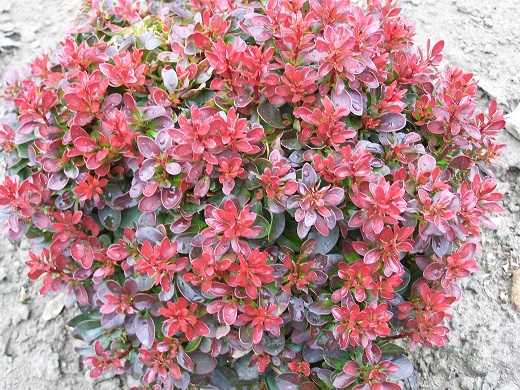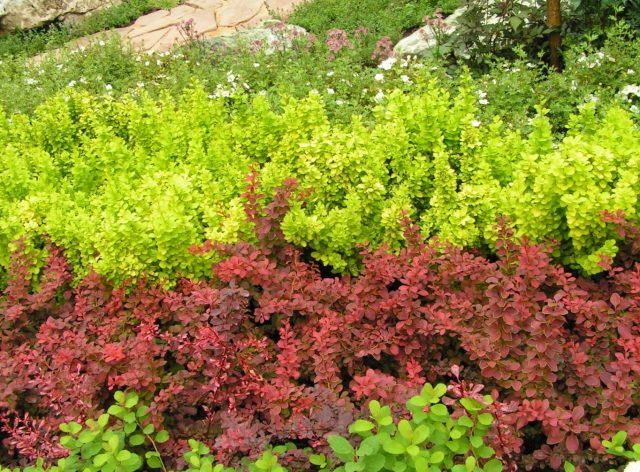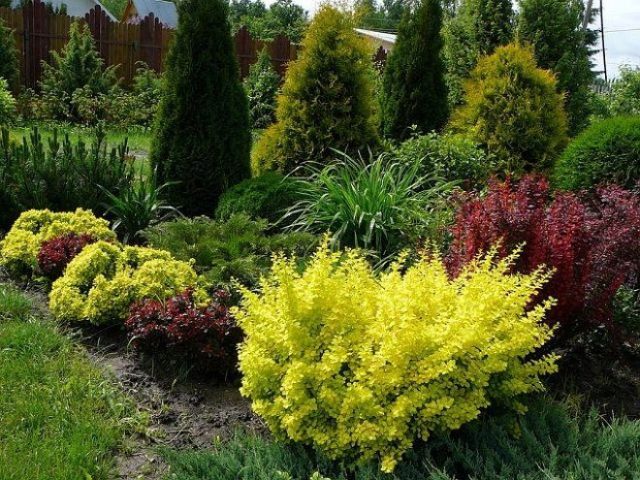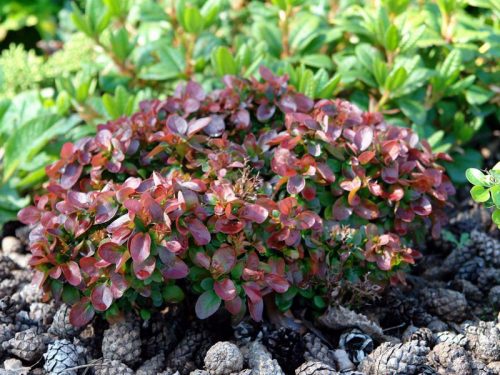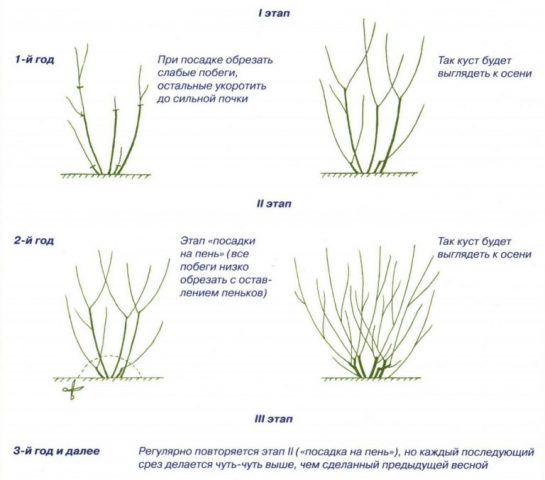Content
Barberry is a beautiful shrub that is used not only for decorative purposes, but also for making medicinal drinks according to traditional medicine recipes. Breeders have bred several dozen varieties of this shrub, each of which has its own advantages and nuances of cultivation. Barberry Bagatelle is one of the most popular varieties that many gardeners and landscape design professionals are well aware of.
Description of barberry Bagatelle
In appearance, this variety is one of the most compact. The width and height of the shrub are 40 cm each. With the correct haircut, you can give the shape of a ball that best suits the given shrub. Young shoots are red-brown in color, but by autumn it changes to pure brown.
The shrub leaves are bright purple in color when exposed to the sun. The size of the leaves is about 1 cm wide. The shape is ovoid. If the plant is in the shade, then the shade changes to green-red. In autumn, the color of the leaves changes back to bright red. Leaves fall off for the winter.
For a year, the shoots grow by about 2 cm. Bagatelle barberry blooms with small yellow flowers, which are collected in inflorescences. The flowering period is May – June. When planting, it prefers a lighted place or light partial shade.
The berries ripen in the second half of September. The fruits of the Bagatelle barberry are oblong, shiny, edible. The shrub is able to withstand heat and drought. It also tolerates frosty winters easily if there is sufficient snow cover.
Barberry Thunberg Bagatelle in landscape design
In landscape design, this type of shrub is used very widely. First of all, these are clipped hedges and various fences.
And also group compositions look beautiful, in which a variety of varieties of barberry are combined.
A compact plant looks beautiful in single plantings, especially in sunny areas.
Various rock gardens and group plantings with the participation of barberry look especially luxurious.
If used correctly, the site can be made into a real greenhouse.
You can arrange a monochromatic landscape using only Bagatelle barberry, as in the photo.
Even a non-professional can cope with the arrangement of the site with the help of barberry. It is important to choose the right planting site, as well as regularly carry out formative pruning.
Planting and caring for the Turnberg barberry Bagatelle
To form a luxurious look in a shrub, it is necessary not only to properly cut it, but also to grow it, in accordance with all the conditions of agricultural technology. Barberry of this variety can be called an unpretentious plant, but there are nuances of care.
The shrub requires watering and feeding, mandatory pruning twice a year, as well as protection against certain diseases and pests that can damage the appearance of the shrub and slow down its growth rate. The very first question that arises before the gardener is where and how to plant the Bagatelle barberry.
Seedling and planting plot preparation
First of all, it is worth deciding on a place. Barberry Bagatelle loves the sun, only in open sunny areas there will be a rich purple color of the leaves. It is worth paying attention to the location of groundwater. Barberry does not like too swampy soils, and root system diseases arise from high humidity.
Bagatelle is unpretentious to soil acidity, although the parameters of neutral acidity are better suited than all the others.The plant will successfully survive the dry summer, it will not grow worse in strong winds, it will survive the frost. In principle, you can choose any convenient place for planting, and with strong soil moisture, simply drainage.
For seedlings, it is advisable to prepare a hole in advance, a couple of weeks before the intended planting. It is recommended to maintain the distance, depending on the garden composition:
- single plantings - 1.5-2 m between shrubs;
- for a dense hedge - 4 shrubs per linear meter;
- for a free hedge - 2 plants per linear meter.
A layer of coarse sand should be covered at the bottom of the hole. If the soil is too wet and the groundwater is close, then it is recommended to lay out drainage from pebbles under the sand. The width of the planting site should be larger than the root system of the seedling.
If the soil is acidic, then it will need liming. For each bush, it is enough to add 300 g of slaked lime to make the soil neutral.
Planting barberry Bagatelle
A nutrient mixture is used for planting. It is made from humus, sand and garden soil. All components must be taken in equal quantities. Landing is carried out as follows:
- A small amount of the nutrient mixture described above should be covered with a slide on top of the drainage.
- Place the seedling, carefully spread the horses.
- Cover everything with the remaining nutrient mixture so that the root collar is at ground level.
- Condense the earth.
- Water the shrub.
- Mulch the seedling with peat.
At the seedling, the part that is located above the ground is cut off, but be sure to leave a site with several healthy buds.
Watering and feeding
Barberry Turnberg Bagatelle, according to the descriptions of experts, categorically does not like excess moisture. It is optimal for him to organize drip irrigation. Or make sure that the root system does not freeze. If the summer is rainy, then you do not need to water the shrub at all. Natural moisture is enough for him.
As for feeding, it is not needed in the first two years of life. Then the plant will need nitrogen fertilizers. Dissolve 30 g of urea in 10 liters of water. This is sufficient until the plant is 6 years old.
And also granular fertilizers, which are applied immediately before the beginning of flowering, do not interfere. In the second year of life, it will not hurt to apply potash fertilizers in the fall.
As necessary, be sure to weed the shrub, and also loosen the soil near it. Before applying fertilizers, loosening is a mandatory procedure. If you don't get rid of weeds, then the bush may develop diseases or pests that will spoil the appearance of Bagateli.
Pruning
Barberry Bagatelle, like any ornamental shrub, freely tolerates pruning. If it is not produced, the appearance deteriorates, growth is inhibited, and the yield of barberry also decreases. There are two types of pruning: sanitary and shaping.
Sanitary pruning of barberry Bagatelle is carried out in the spring, when it is necessary to remove frozen and diseased shoots. In addition, dead branches must be removed throughout the season. A large number of dry shoots negatively affects the health of the entire shrub.
For the arrangement of hedges, formative pruning is carried out in the second year after planting, and then every year 2 times - in early June and August. Both times cut from 1/3 of the length to 2/3.
The Bagatelle shrub is so compact that in some hedges it doesn't even need pruning. With single plantings, Bagatelle barberry can easily be given any shape, but spherical is preferable.
For proper pruning, you need good quality and sharp tools: a hacksaw, pruning shears, brush cutters.
Preparing for winter
If there is no guarantee that the winter will be snowy, then the shrub will have to be prepared. Barberry Bagatelle is capable of tolerating frost, but preferably under a layer of snow. In the first two years, it is recommended to cover the seedling. For this, spruce branches, peat or straw are successfully used. In an older age, you can only cover the root zone. In very harsh winters, some gardeners bend side branches to the soil and also insulate them with spruce branches.
Reproduction
Reproduction of the Bagatelle barberry occurs in different ways. Each gardener chooses the most convenient method for himself. Bagatelle multiplies:
- Layers and root shoots - the method is used infrequently, since the processes do not always retain all the characteristics of the mother plant. They can also "run wild".
- Seeds. A troublesome method, especially since the seeds have only 40% germination capacity. The seedling is obtained only two years after planting. The process is laborious and therefore time consuming.
- Cuttings - the most popular and easiest way to propagate the Bagatelle shrub. For cuttings, cuttings obtained in summer or autumn are used. But summer pruning is considered a better option.
- By dividing the bush - when transplanting, the mother bush is divided into several parts, each of which becomes an independent plant.
After planting, the care of the seedling in the first year is carried out more thoroughly, until the plant completely takes root and begins to bloom and bear fruit.
Diseases and pests
The most common diseases of the bagatelle barberry:
- powdery mildew;
- rust;
- spotting of various types;
- withering.
It should be treated with specialized preparations, according to the instructions.
Of the pests, the most dangerous is the barberry aphid, which leads to wilting and wrinkling of the leaves. For prevention and as a treatment, soap and tobacco solutions are used.
Conclusion
Barberry Bagatelle is used to decorate plots, and its fruit is a healing agent that is used in many traditional medicine recipes. This variety is compact and unpretentious. Admiration is caused by the red leaves, which look especially rich in sunny areas. In the presence of shadow, the leaves become greenish, which no longer looks so luxurious.
